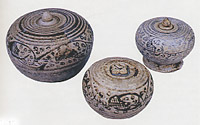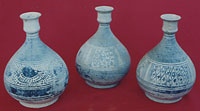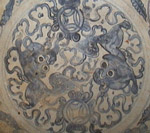Breech of bronze cannon. The design is Portuguese, but the decorative medallion looks like one of the Eight Buddhist Emblems, so they may have have been cast in Asia

| Discovering Asia's ceramic development |
|
Breech of bronze cannon. The design is Portuguese, but the decorative medallion looks like one of the Eight Buddhist Emblems, so they may have have been cast in Asia |
 |
This shipwreck was discovered in 53 metres of water, 39 nautical miles from the nearest Malaysian island. The site is unusual, with no hull remains, but many indications that a ship once rested there. This ship may have been built from a softer wood. About 170 Chinese blue-and-white ceramics and 30 underglaze pieces of late style from Sukothai and Sisatchanalai were found partly buried in mud within the original outlines of the ship.
Six of these pieces bear reign marks of emperor Xuande (1426-1435). These were mixed with other pieces normally attributed to the 16th century - and two bronze cannon of a Portuguese style which first appeared in Portugal in the 1520s. This sets the earliest possible date for the wreck.
The use of a Xuande reign mark on an item made decades later does not necessarily imply that it was a fake. The Xuande reign was a period of stability, prosperity and cultural excellence: the use of the reign mark may have been commemorative, or regarded as an integral part of a classic design.
 |
 |
The absence of celadon on this wreck and the later Singtai is interesting, given that both ships carried underglaze products from Sisatchanalai and Sukhothai. Perhaps Sisatchanalai had ceased to export celadon, and switched back to underglaze decorated ware (not seen on the Nanyang, Longquan or Royal Nanhai), with new decorative styles and shapes - such as covered boxes, and bottles with cup shaped mouths. Many of the boxes were fired on tubular supports.
Meanwhile, Sukhothai had apparently abandoned its famous fish and flower plates - but the presence of Sukhothai ceramics on the Xuande and Singtai shows that the kilns were still active in the 16th century, which is new information. Only one type of Sukhothai ware is found on the Xuande: bowls with a cakra or solar whorl medallion. Some of these have a 'yin-yang' symbol in the centre. The bowls vary from 12 to 20cm in diameter, and 6-9cm in height. Many have scars from spur discs; none show signs of tubular supports.
Storage jars include a new bulbous, lug handled type from Maenam Noi, and tall bottles with ring handles trailing down the side (seen left foreground in the photographed display).
 Two lion dogs with cash emblems among swirling ribbons, from a dish with peony blossoms on cavetto & exterior. |
Forms and decorations sometimes remained in use for many centuries. Lion dogs, such as those in the Chinese design here, will recur three centuries later on the Desaru - although then in highly stylised form.
| Exhibition index |